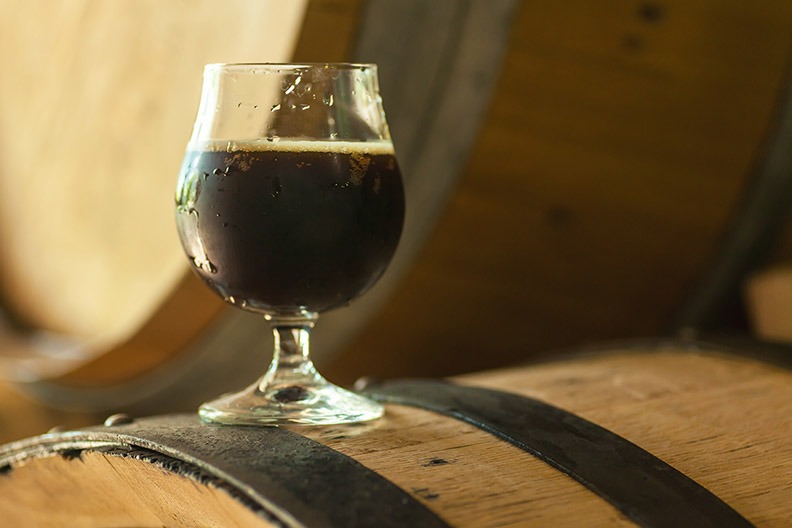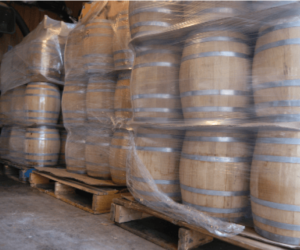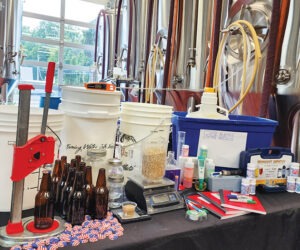Buying, Using & Maintaining a Barrel
Beer and barrels just seem to go together — at least in some drinking songs. Why would you store beer in a vessel with a potential for sanitation issues, that slowly lets in oxygen as the beer is aged and can’t hold pressure? There are a couple possible answers to this question. Some brewers age their beer in bourbon barrels to impart a mixed oak and whiskey flavor to their beers. Others brew sour beers and the “bugs” in the wood and oxygen permeability might be just what they are looking for. Finally, some brewers may simply be looking to add a little oak character to a regular (non-sour) beer. This article will explain how to maintain a new, “clean” barrel for oak-aging your beer.
Buying a Barrel
When you first buy a barrel, new or used, thoroughly inspect the interior and exterior of the barrel for any potential problems. Visually inspect the interior by inserting a small light source through the bung hole. Look for any obvious wood defects, wide joint gaps, or excessively charred wood resulting from over-toasting. Toasted wood should have a smooth finish with a uniform brownish color. Charred wood will look damaged and can be easily detected because it has a very dark brown, almost black, color.
On the exterior, ensure that stave and head joints are narrow and tight, hoops are properly fastened, and the bung hole is tapered and not damaged.
New Barrel Maintenance
To minimize maintenance, wait to buy new barrels until you are ready to use them. Otherwise, store empty barrels in a cool and humid area, 55 °F (13 °C) and 65–75 percent humidity, respectively, and away from dampness, to minimize shrinkage.
Protect empty barrels from spoilage organisms by burning sulfur inside the barrels to replace the air with sulfur dioxide (SO2) gas. Barrels can be stored empty for an indefinite amount of time when properly preserved with sulfur. Once a month, gently sniff the inside of each barrel to determine if any SO2 gas is still present. If detected, simply replace the bung; otherwise, burn more sulfur. Be sure to work in a well-ventilated area and avoid inhaling SO2 gas.
A “sulfur bung” for burning sulfur sticks or discs can be used for this purpose. This device — which can be found at most winemaking shops — is used to hold burning sulfur and prevent sulfur deposits from falling into the barrel. Deposits left in the barrel will interact with beer during aging, causing hydrogen sulfide (H2S) to form.
To prepare an empty barrel for storage, thoroughly rinse the interior with water and let it drain completely. No puddling of water should remain in the bilge; otherwise, it will cause sulfur dioxide gas to hydrate and form into sulfurous acid.
Light a piece of sulfur stick and deposit it in the metal container at the bottom of the sulfur bung. If using a sulfur disc, place it on the hook over the metal container, and light it. Insert the burning sulfur attachment in the barrel and seat the wooden bung in the hole. The sulfur will burn completely in a few minutes to fill the barrel with gas. Remove the sulfur bung and quickly insert a wooden bung to prevent gas from escaping.
Do not attempt to sanitize a used bourbon barrel in this manner. Alcohol vapors and open flame are a bad combination.
New Barrel Preparation
A new barrel must be swelled with clean water before transferring beer into it; otherwise, it will leak. If beer leaks through stave or head joints, or the croze, there may be considerable loss. There may also be premature oxidation of the beer as air enters the barrel. Eventually, if untreated, mold will form on the exterior surface and will penetrate through the joints to contaminate the beer. By swelling barrels, all joints will tighten to eliminate any possibility of beer seepage and prevent spoilage problems.
You can swell a new barrel using a hot-water treatment or using an overnight water-soaking treatment. First, let all the SO2 gas out and thoroughly rinse the inside of the barrel with lukewarm water.
The hot-water treatment method is very effective and requires little water. Pour approximately a 20 percent volume of very hot, steamy, clean tap water into the barrel. For example, use three gallons (11 L) of hot water for a 15-gallon (57-L) barrel. Bung the barrel and slosh it around to soak the entire interior surface. The vapor pressure and hot water significantly accelerate barrel swelling and “plug” any seepage through joints. Continue sloshing the barrel until there is no more leakage. Then place it upright and let the head area soak until there is no more leakage. Repeat with the other head area. When done, let the water drain completely and let the barrel dry and cool down before transferring beer into it. If the barrel does not stop leaking within one hour of pouring the hot water, proceed with an overnight treatment.
The overnight treatment should fix any leakage unless the barrel is defective. However, it will leach out some of the oak flavor owing to the longer soak period. This is fine for new barrels because you may want to reduce the amount of oak that will be imparted to that first batch of beer.
Fill the barrel to the top with cool water and let it soak overnight. Initially, the barrel may leak but it should stop after a few hours or a day. The soak period should never exceed 24–36 hours with the same water to avoid mold developing and penetrating the barrel. If there is still leakage, refill the barrel and repeat until leakage stops. If leakage does not stop after four to five days, the barrel is defective and should be returned to your supplier. When leakage has stopped, drain the water out of the barrel by placing it in the bung-down position. Let the barrel stand for an hour or two and then fill it immediately with beer.
The barrel’s exterior surface requires no special preparation, although you should inspect it regularly for any mold.
Used Barrel Maintenance
Used barrels must also be properly stored and maintained; however, since these previously contained beer or another liquid, a different maintenance program is recommended.
If used barrels are to be stored empty, rinse them several times with clean water, and drain. If left empty, the barrel wood will dry and shrink over time, and will therefore require to be swelled again when transferring beer into it. An effective alternative is to fill and store barrels with a sulfur-citric holding solution. This holding solution will promote sanitation, keep the barrels swelled and smelling sweet. It is not recommended for new barrels, barrels less than one year old or barrels previously holding spirits such as bourbon since precious oak or other flavors would be stripped.
The holding solution is prepared using 1 tsp of citric acid and 1.5 tsp of potassium metabisulfite for each gallon (4 L) of barrel volume. Dissolve these in one gallon of hot water. Fill the barrel two-thirds with water, add the holding solution, top up the barrel with cool water, and bung the barrel. Top up the barrel with a holding solution once a month to replace lost solution. The barrel can be stored indefinitely without the risk of spoilage. During storage, rotate the barrel 45° in either direction every time you top up to keep the bung area soaked. This will prevent the bung area from drying out and protect it from spoilage organism growth. The sulfur-citric holding solution will etch a concrete floor. Rinse the floor with water to prevent this.
Used barrels require no special preparation beyond a simple water rinse, if desired, when transferring beer out and in immediately. If the barrel has been stored with a holding solution, drain the barrel and rinse it thoroughly with clean water before transferring beer into it.
Barrel “Bugs”
Sanitation can be a problem with oak barrels. Penicillium mold — a blue-green fungus — is the most common spoilage problem and can be very difficult to eradicate. Typically, it will grow through joints or around the bung hole in barrels that have not been properly swelled. The “usual suspects” may also inhabit the wood in a barrel. These include Acetobacter (especially in barrels that are not topped up regularly), Brettanomyces (which can subsist on the wood cellulose sugars in new barrels), Lactobacillis and Pediococcus.
To treat any of the above spoilage problems, prepare an alkaline solution by dissolving either sodium carbonate or sodium percarbonate in water at a rate of 1 tsp per gallon (or use 1 g/L) for mild spoilage problems or up to a maximum of 3 tsp for more serious problems. Fill the barrel two-thirds of the way with water, add the solution to the barrel and then top up with water.
Let the barrel soak overnight, empty it and neutralize any remaining alkaline residues using a citric acid solution. Prepare the citric acid solution by dissolving citric acid powder in one gallon of water. Use 1 tsp of powder for each gallon of barrel volume. For example, dissolve 15 tsp. for a 15-gallon (57 L) barrel.
Armed with these techniques, you’ll be able to “roll out the barrel” whenever you wish to wood-age a beer.




